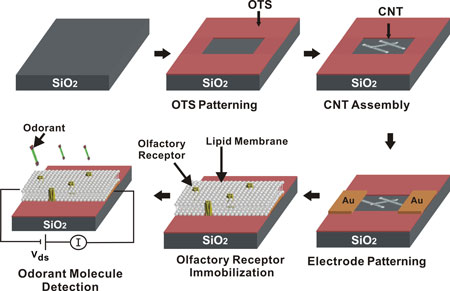Researchers have been trying for a while to replicate the human olfactory sense - a concept called electronic nose (e-nose). Nanotechnology holds great promise in realizing this goal. While most efforts have focused on nanowires, new research conducted in Korea has demonstrated the detection of specific odorant molecules with a single-carbon-atomic resolution using a human olfactory receptor-functionalized carbon nanotube (CNT) based sensor.
"We have fabricated carbon nanotube-based field effect transistors (FETs), which can detect electrical potential changes around them, and then, for the first time, we successfully coated these FETs with cell membranes containing olfactory receptors which specifically bind to 'fruit flavor' odorant molecules," Seunghun Hong tells Nanowerk.
Hong, an associate professor of physics at the Hybrid Nano-Device & Nano-Assembly Lab at Seoul National University, and his group, together with collaborators from Tai Hyun Park's group at the university's Institute of Bioengineering, have developed a strategy that overcomes the poor selectivity problem that characterized previous chemical sensors. They accomplished this by combining human olfactory receptors as a sensing element, while single-walled CNT-FETs enabled the high sensitivity of the sensors.
The team first tried to combine CNT-FETs with entire human olfactory cells but found it extremely difficult to grow these cells on FETs. When they decided instead to coat their nanotubes only with cell membranes that contained receptor proteins they got successful results.

(Picture on the left= Fabrication of human olfactory receptor-functionalized single-walled CNT-FET sensors.)
"When we introduced 'fruit flavor' odorant molecules to the coated CNT-FETs, the odorant molecules attached to the olfactory receptors on the CNT-FETs," Hong explains the workings of their e-nose."This binding deformed the olfactory receptors and changed the electric potential around them, which was detected by the underlying CNT-FETs."
The result is that these coated CNT-FETs work as a highly-specific and sensitive odorant sensor which can detect specific odorant molecules just like the human nose. What is most significant about this device is that - since the binding of human olfactory receptors is extremely specific - it can distinguish different molecules with only a single-carbon-atom difference.
Hong's team has reported their findings in Advanced Materials ("Single-Carbon-Atomic-Resolution Detection of Odorant Molecules using a Human Olfactory Receptor-based Bioelectronic Nose").
Most previous 'electrical nose' and other gas sensors utilized semiconductor-based FETs which are not highly specific and respond to multiple gases. This work by the Korean scientists represents a significant advance in gas sensor technology and electrical nose applications because it allows to build highly specific odorant sensors. It might allow the fabrication of advanced sensors for detecting hazardous materials, the screening of new perfume ingredients for the cosmetics industry, or developing artificial noses for elderly people to regain their lost sense of smell.
Furthermore, according to Hong, this work can provide a significant advance in the biophysics area."Our results show that we can monitor the deformation of membrane proteins such as olfactory receptors using our CNT-FETs," he says."Membrane proteins (e.g. olfactory receptor, ion channels) usually lose their shape and functionality once they leave the cell membrane. Therefore it is extremely difficult to study or monitor these membrane proteins. Our work provides CNT-FETs as a new tool to monitor the electrical potential of the membrane protein in real time."
January 15, 2009
SNU PR Office

